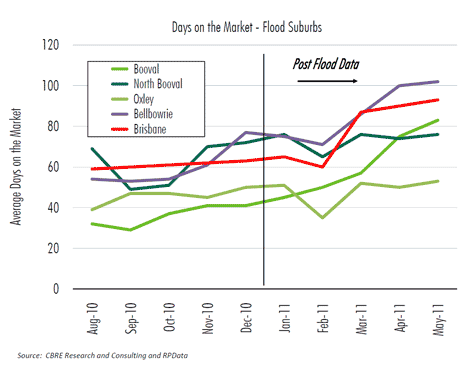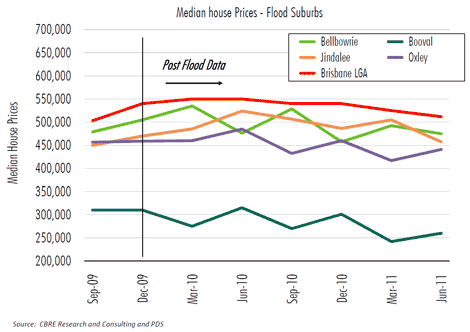Brisbane buyers shun flood-affected properties: API
Some 70% of prospective Brisbane home buyers will not consider purchasing a house that was inundated during last year's floods, a report by the Australian Property Institute has found.
The report concluded that homes that were completely inundated last January have dropped more than 20% in value and took a month longer to sell than unaffected homes.
There was a decline in value of between 10% and 20% for properties where flood waters had partially affected living areas.
Homes that experienced only minor flooding of the garden dropped in price by between zero and 10%, the report found.
Even properties that remained dry in flood-affected areas have been affected, with the report noting national house prices have fallen by 3.4% and Brisbane house prices by 6.1%.
Tradesmen were the main buyers of flood-affected properties. Within the Brisbane region, flooding impacted upon parts or all of the following areas, among others: Milton, Toowong, Auchenflower, Rocklea, Goodna, Ipswich, Yeronga, Bellbowrie, Booval, Oxley and Jindalee.
The report found many investors had been the ones who decided to sell at discounted prices rather than carry out home repairs from a distance.
“Initially there was a steady turnover of flooded properties, generally for properties in the entry-level segment of the market.
“The owners of these properties were typically interstate or overseas investors who were unable to coordinate the required repairs and also felt that by the time they paid for repairs and factored in the lost rental income that it was easier for them to move the property on quickly,” the report says.
Brisbane valuer Gavin Hulcombe said the proximity of the flood to the November 2010 interest rate rise also helped to exacerbate any drop in value.
"There's no doubt that the two coincided. In a soft market negative attributes of a property are exaggerated.''
Hulcombe says insurance would play a role in how well the market recovered in flooded areas.
"One of the issues going forward will be availability and the cost of insurance to those properties,'' he says.
"If that becomes prohibitive then that's always going to be an issue that is going to impact buyers' minds,” he told The Courier Mail.
He notes the flood inundation of significant areas within Brisbane and further to the west, including Ipswich and the Lockyer Valley, has fundamentally impacted the Queensland residential property market.
At the peak of the flood, approximately 11,900 homes were completely flooded and a further 14,700 homes were partially flooded.
Hardest hit suburbs were West End, Rocklea, Graceville, Milton, St Lucia and Bellbowrie.
Almost 12 months on the clean?up continues, the report notes, along with limited stock coming onto the market.
“Many owner-occupiers of flood?affected properties have decided to carry out repairs to the dwelling and sit tight for the medium term until the market starts to recover,” the report says.

“There has been a limited amount of riverfront prestige properties in excess of $2 million coming onto the market in 2011.
“In the last couple of months some properties have come onto the market although there has been limited demand at present, despite the fact the properties are for sale often below replacement value,” says API president Philip Willington.
“As a result of the changes to the minimal habitable floor level by the Brisbane City Council it is possible that a sub-sector of the market in the under $1 million price bracket may develop.
“One sector of the market will comprise properties that were affected by flooding and carried out the necessary repairs, whilst the other sector of the market will comprise flood-affected properties where the owners have raised the dwelling to the new minimum habitable floor level as well as carrying out the necessary repairs," Willington says.
“The market may view more favourably the properties that have been raised to try and mitigate any future flooding events.”
But the overall market within the flood-affected properties was expected to remain subdued for the medium term.

Along with minimal demand in the general property market, the flood-affected suburbs were likely to have lower levels of supply and limited demand.
”As time goes by, and floods do not re?occur, as seems likely, history suggests that the discount will shrink, though not disappear entirely.
“The floods of 1974 provide a good indication of the pricing correction that is likely to now occur,” Willington says.
“Properties flooded in 1974 experienced an immediate fall in demand from purchasers and we have seen a similar trend in 2011.
“For owner-occupiers and investors looking to buy, the knowledge that Wivenhoe Dam (completed in 1984) cannot necessarily stop future flooding in Brisbane is likely to form a key factor in the due diligence process.
“The longer term influence of the 1974 floods on property prices diminished as buyers became less cautious about the likelihood of another significant flood event and perhaps more focused on issues such as the high population growth rate in south-east Queensland.”
As memories faded about the damage in 1974 to suburbs such as St Lucia, Indooroopilly, Graceville, Chelmer and West End, substantial price growth occurred in these suburbs.
“One could therefore expect that in the longer term, upwards of 10 years, if there are no further flood events, there may be a rebound of the flood affected areas as the memories of 2011 become more distant,” the report says.
The Australian Property Institute represents 8,600 property professionals. API members include residential and commercial valuers.
The report was compiled with the assistance of CBRE, Herron Todd White and Propell National Valuers.